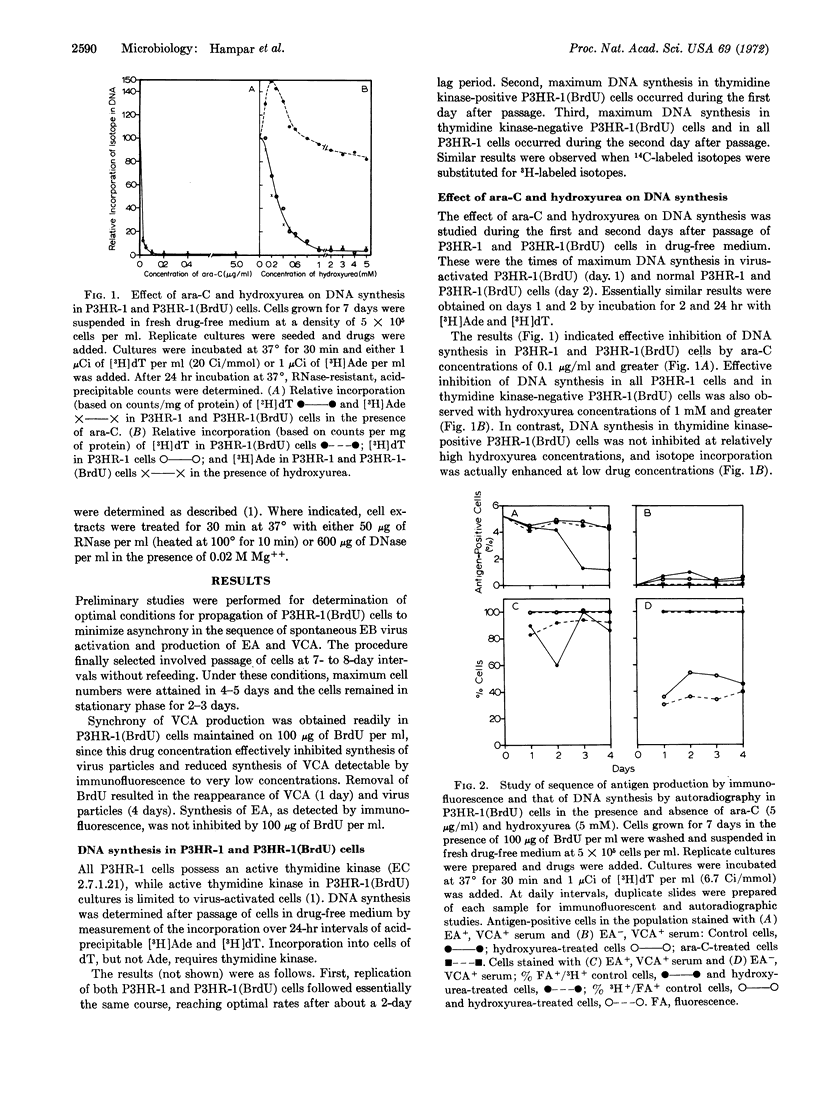Abstract
The sequence of spontaneous Epstein-Barr virus activation was studied in P3HR-1 carrier cells and in P3HR-1(BrdU) cells made resistant to 5-bromodeoxyuridine. Virus activation was initiated during the normal cell cycle, and recruitment of additional virus-activated cells was prevented by the DNA inhibitors, 1-β-D-arabinofuranosylcytosine and hydroxyurea. Virus activation was followed by synthesis of the early antigen complex in the absence of additional detectable DNA synthesis. Early antigen synthesis was followed by hydroxyurea-resistant synthesis of new DNA, which in the case of P3HR-1(BrdU) cells was characterized by the appearance of thymidine kinase. The newly synthesized DNA banded in neutral cesium chloride at peaks corresponding to normal human DNA and Epstein-Barr viral DNA. Synthesis of viral antigen was seen only in cells that had undergone hydroxyurea-resistant DNA synthesis.
Keywords: 5-bromodeoxyuridine, early antigen, viral antigen, thymidine kinase
Full text
PDF




Images in this article
Selected References
These references are in PubMed. This may not be the complete list of references from this article.
- Gerber P. Activation of Epstein-Barr virus by 5-bromodeoxyuridine in "virus-free" human cells (complement-fixing antigen-immunofluorescence-leukocytes). Proc Natl Acad Sci U S A. 1972 Jan;69(1):83–85. doi: 10.1073/pnas.69.1.83. [DOI] [PMC free article] [PubMed] [Google Scholar]
- Gergely L., Klein G., Ernberg I. The action of DNA antagonists on Epstein-Barr virus (EBV)-associated early antigen (EA) in Burkitt lymphoma lines. Int J Cancer. 1971 Mar 15;7(2):293–302. doi: 10.1002/ijc.2910070214. [DOI] [PubMed] [Google Scholar]
- Glaser R., O'Neill F. J. Hybridization of Burkitt lymphoblastoid cells. Science. 1972 Jun 16;176(4040):1245–1247. doi: 10.1126/science.176.4040.1245. [DOI] [PubMed] [Google Scholar]
- Hampar B., Derge J. G., Martos L. M., Walker J. L. Persistence of a repressed Epstein-Barr virus genome in Burkitt lymphoma cells made resistant to 5-bromodeoxyuridine. Proc Natl Acad Sci U S A. 1971 Dec;68(12):3185–3189. doi: 10.1073/pnas.68.12.3185. [DOI] [PMC free article] [PubMed] [Google Scholar]
- Hampar B., Derge J. G., Martos L. M., Walker J. L. Synthesis of Epstein-Barr virus after activation of the viral genome in a "virus-negative" human lymphoblastoid cell (Raji) made resistant to 5-bromodeoxyuridine (thymidine kinase-virus antigen-immunofluorescence-herpesvirus fingerprints). Proc Natl Acad Sci U S A. 1972 Jan;69(1):78–82. doi: 10.1073/pnas.69.1.78. [DOI] [PMC free article] [PubMed] [Google Scholar]
- Hampar B., Gerber P., Hsu K. C., Martos L. M., Walker J. L., Sigüenza R. F., Wells G. A. Immunoferritin and immunofluorescent studies with Epstein-Barr virus and herpes simplex virus by use of human sera and hyperimmune rabbit sera. J Natl Cancer Inst. 1970 Jul;45(1):75–85. [PubMed] [Google Scholar]
- Hampar B., Martos L. M., Walker J. L. Epstein-Barr virus in human lymphoblastoid cells: enhancing the percentage of virus-positive cells by cocultivation with African green monkey (Vero) cells. J Natl Cancer Inst. 1971 Sep;47(3):535–537. [PubMed] [Google Scholar]
- Henle G., Henle W. Immunofluorescence in cells derived from Burkitt's lymphoma. J Bacteriol. 1966 Mar;91(3):1248–1256. doi: 10.1128/jb.91.3.1248-1256.1966. [DOI] [PMC free article] [PubMed] [Google Scholar]
- Henle W., Henle G., Zajac B. A., Pearson G., Waubke R., Scriba M. Differential reactivity of human serums with early antigens induced by Epstein-Barr virus. Science. 1970 Jul 10;169(3941):188–190. doi: 10.1126/science.169.3941.188. [DOI] [PubMed] [Google Scholar]
- Lieberman M. W., Sell S., Farber E. Deoxyribonucleoside incorporation and the role of hydroxyurea in a model lymphocyte system for studying DNA repair in carcinogenesis. Cancer Res. 1971 Sep;31(9):1307–1312. [PubMed] [Google Scholar]
- Nii S., Rosenkranz H. S., Morgan C., Rose H. M. Electron microscopy of herpes simplex virus. 3. Effect of hydroxyurea. J Virol. 1968 Oct;2(10):1163–1171. doi: 10.1128/jvi.2.10.1163-1171.1968. [DOI] [PMC free article] [PubMed] [Google Scholar]
- Nonoyama M., Pagano J. S. Detection of Epstein-Barr viral genome in nonproductive cells. Nat New Biol. 1971 Sep 22;233(38):103–106. doi: 10.1038/newbio233103a0. [DOI] [PubMed] [Google Scholar]
- Warner H. R., Hobbs M. D. Effect of hydroxyurea on replication of bacteriophage T4 in Escherichia coli. J Virol. 1969 Mar;3(3):331–336. doi: 10.1128/jvi.3.3.331-336.1969. [DOI] [PMC free article] [PubMed] [Google Scholar]
- YOUNG C. W., HODAS S. HYDROXYUREA: INHIBITORY EFFECT ON DNA METABOLISM. Science. 1964 Nov 27;146(3648):1172–1174. doi: 10.1126/science.146.3648.1172. [DOI] [PubMed] [Google Scholar]
- Zur Hausen H., Schulte-Holthausen H. Presence of EB virus nucleic acid homology in a "virus-free" line of Burkitt tumour cells. Nature. 1970 Jul 18;227(5255):245–248. doi: 10.1038/227245a0. [DOI] [PubMed] [Google Scholar]



